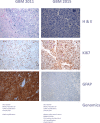Future paradigms for precision oncology
- PMID: 27223079
- PMCID: PMC5216837
- DOI: 10.18632/oncotarget.9488
Future paradigms for precision oncology
Abstract
Research has exposed cancer to be a heterogeneous disease with a high degree of inter-tumoral and intra-tumoral variability. Individual tumors have unique profiles, and these molecular signatures make the use of traditional histology-based treatments problematic. The conventional diagnostic categories, while necessary for care, thwart the use of molecular information for treatment as molecular characteristics cross tissue types.This is compounded by the struggle to keep abreast the scientific advances made in all fields of science, and by the enormous challenge to organize, cross-reference, and apply molecular data for patient benefit. In order to supplement the site-specific, histology-driven diagnosis with genomic, proteomic and metabolomics information, a paradigm shift in diagnosis and treatment of patients is required.While most physicians are open and keen to use the emerging data for therapy, even those versed in molecular therapeutics are overwhelmed with the amount of available data. It is not surprising that even though The Human Genome Project was completed thirteen years ago, our patients have not benefited from the information. Physicians cannot, and should not be asked to process the gigabytes of genomic and proteomic information on their own in order to provide patients with safe therapies. The following consensus summary identifies the needed for practice changes, proposes potential solutions to the present crisis of informational overload, suggests ways of providing physicians with the tools necessary for interpreting patient specific molecular profiles, and facilitates the implementation of quantitative precision medicine. It also provides two case studies where this approach has been used.
Keywords: genomics; metronomic chemotherapy; precision medicine; targeted therapy.
Conflict of interest statement
There is no conflict of interest.
Figures





References
-
- Hanahan D, Weinberg RA. Hallmarks of cancer: the next generation. Cell. 2011;144:646–674. - PubMed
-
- Hanahan D, Weinberg RA. The hallmarks of cancer. Cell. 2000;100:57–70. - PubMed
-
- Egas-Bejar D, Anderson PM, Agarwal R, Corrales-Medina F, Devarajan E, Huh WW, Brown RE, Subbiah V. Theranostic Profiling for Actionable Aberrations in Advanced High Risk Osteosarcoma with Aggressive Biology Reveals High Molecular Diversity: The Human Fingerprint Hypothesis. Oncoscience. 2014;1:167–179. doi: 10.18632/oncoscience.21. - DOI - PMC - PubMed
-
- Heisterkamp N, Groffen J, Stephenson JR, Spurr NK, Goodfellow PN, Solomon E, Carritt B, Bodmer WF. Chromosomal localization of human cellular homologues of two viral oncogenes. Nature. 1982;299:747–749. - PubMed
Publication types
MeSH terms
LinkOut - more resources
Full Text Sources
Other Literature Sources

